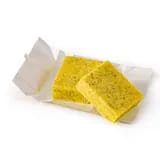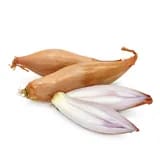Ingredients
Make sure you have...
Utensils
Stovetop, Kettle, Pot (small), Frying pan
recipe

Step 1
Boil 25 cl of water per portion, add the bouillon cube and stir to dissolve.

Step 2
Peel and mince the shallots.

Step 3
Cut the squash in half, scoop out the seeds, then cut into large chunks.
Step 4
In a pot, melt 1 tsp butter; add the shallot and squash and sauté for 8-10 mins.


Step 5
Add the rice & the wine. Simmer until absorbed.

Step 6
Add 1 ladleful of broth. Simmer until absorbed, then add another.

Step 7
Repeat with the remaining vegetable broth. After 18-20 minutes, the rice should be cooked.

Step 8
When the rice is done, add the parmesan, salt and pepper and mix.

Step 9
In a pan, toast the hazelnuts for 3 minutes over medium-low heat, then crush or roughly chop.

Step 10
Serve the risotto, sprinkled with ground black pepper and the hazelnuts.
Personal notes
Add your own flavor!
Nutrition facts
Average estimated amount for one serving
| Energy | 479 cal. |
| Fat | 13 g |
| Carbohydrates | 65 g |
| Protein | 15 g |
| Fiber | 5 g |
Values are based on an average estimate for one serving. All nutrition information presented on Jow is intended for informational purposes only. If you have any concerns or questions about your health, please consult with a health-care professional.
On average, one serving of the recipe "Squash Risotto" contains 479 Energy, 13 g of Fat, 65 g of Carbohydrates, 15 g of Protein, 5 g of Fiber.
Price per portion
| € | Nos recettes à -2 € par portion |
| €€ | Nos recettes entre 2 € et 4 € par portion |
| €€€ | Nos recettes à +4 € par portion |
Please note, the price above is dependent on your grocer and the available products in the grocery store you chose.
Scores


A Nutri-score
The Nutri-score is an indicator intended for understanding nutritional information. Recipes or products are classified from A to E according to their food composition to promote (fiber, proteins, fruits, vegetables, legumes, etc.) and foods to limit (energy, saturated fatty acids, sugars, salt, etc.).
A+ Green-score
The Green-score is an indicator representing the environmental impact of food products. The recipes or products are classified from A+ to F. It takes into account several factors on the pollution of air, water, oceans, soil, as well as the impacts on the biosphere. These impacts are studied throughout the product life cycle.
Retrieving reviews...



